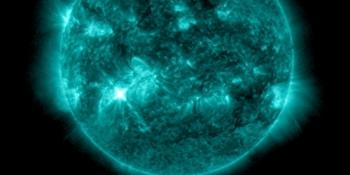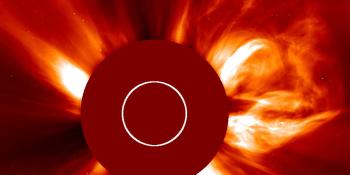Przeglądasz Archiwum z poniedziałek, 22 października 2001
Raport aktywności słonecznej
Każdy wspomniany rozbłysk słoneczny w tym raporcie ma współczynnik skalowania dodany przez Space Weather Prediction Center (SWPC). Przez skale współczynników SWPC, raporty o rozbłyskach słonecznych są o 42% mniejsze niż naukowo jakościowa data. Skale współczynników zostały usunięte z naszych archiwów o rozbłyskach słonecznych by odzwierciedlić prawdziwe jednostki fizyczne.
Raport aktywności słoneczno- geomagnetycznej 2001 Oct 22 2200 UTCPrzygotowane przez NOAA © SWPC i przetworzone przez SpaceWeatherLive.com
Połączenie raportów USAF/NOAA o słonecznej i geofizycznej aktywności
Numer SDF 295 wydany w 2200Z na 22 Oct 2001IA. Analiza aktywności regionów słonecznych i aktywność od 21-2100Z do 22-2100Z Solar activity was at high levels. Region 9672
(S18E13) produced an X1/2b flare at 22/1759 UTC and an associated
Type II radio sweep with a shock velocity estimated at 1043 km/s.
More than 20 twenty percent umbral coverage of large asymmetrical
spot was observed in H-alpha. Shortly before this flare, Region
9672 had produced an M6/2n at 22/1508 UTC which had also produced a
Type II and IV radio sweep (shock velocity estimated at 955 km/sec).
Region 9672 had formed a strong delta configuration earlier in
period. LASCO/EIT imagery has not updated sufficiently, to be able
to ascertain, if a CME was created from either of these flares.
Region 9658 (rotated of west limb at S15) produced an M1/Sf at
22/0040 UTC before exiting the visible disk. New Region 9677 (N20E48)
was numbered today.
IB. Prognoza aktywności słonecznej
Solar activity is expected to be at
moderate to high levels. Region 9672 remains capable of
producing further M-class or isolated major flares.
IIA. Podsumowanie aktywności geofizycznej 21-2100Z do 22-2100Z
The geomagnetic field was at minor to major storm levels. The second
CME passage that had been expected today appears to have been
incorporated into the first, creating minor to major storm conditions
for the entire period aside from a couple isolated severe storm
conditions at high latitudes. The estimated Afr (based on Boulder
magnetometer) reading reached 59 and USAF planetary reached 75.
The greater than 10 MeV proton flux at geosynchronous orbit exceeded
threshold at 22/1910 UTC. At the time of issue of this bulletin the
10 MeV proton flux was at 17 pfu.
IIB. Prognoza aktywności geofizycznej
The geomagnetic field is
expected to remain at active to major storm levels through the first
part of day one. The field should return to quiet to active
conditions at the end of days one and two. Day three should see
minor to isolated major storm conditions return due a potential CME
passage from activity seen in Region 9672 on 22 October. Protons
are expected to remain above 10 MeV through the first day of period.
III. Prawdopodobieństwa zdarzenia 23 Oct do 25 Oct
| Klasa M | 80% | 80% | 75% |
| Klasa X | 40% | 40% | 30% |
| Proton | 99% | 50% | 10% |
| PCAF | red | ||
IV. Przepływ 10,7 cm z Penticton
Zaobserwowano 22 Oct 233 Przewidywane 23 Oct-25 Oct 230/220/220 Średnia z 90 dni 22 Oct 192
V. Indeks geomagnetyczny A
Zaobserwowano Afr/Ap 21 Oct 029/040 Szacowane Afr/Ap 22 Oct 045/075 Przewidywane Afr/Ap 23 Oct-25 Oct 015/030-015/015-020/030
VI. Prawdopodobieństwa aktywności geomagnetycznej 23 Oct do 25 Oct
| A. Średnie szerokości geograficzne | |||
|---|---|---|---|
| Aktywne | 40% | 40% | 50% |
| Słaba burza | 20% | 15% | 30% |
| Bardzo znacząca burza | 01% | 05% | 10% |
| B. Wysokie szerokości geograficzne | |||
|---|---|---|---|
| Aktywne | 60% | 40% | 40% |
| Słaba burza | 30% | 20% | 40% |
| Bardzo znacząca burza | 10% | 05% | 15% |
Wszystkie czasy w UTC
<< Idź do codziennego przeglądu
Najnowsze wiadomości
Najnowsze wiadomości z forum
Season greetings from SpaceWeatherLive 52024/12/23 AR13932 M8.9 & M4.1 associated CMEs 21Ask your obscure/"stupid" space weather questions. 129A little bit about our hobby for the general public 10AR 13932 84
Więcej tematówWesprzyj SpaceWeatherLive.com!
Wielu ludzi odwiedza SpaceWeatherLive aby śledzić aktywność słoneczną lub sprawdzić czy jest szansa na zaobserwowanie zorzy polarnej. Niestety, większy ruch na stronie oznacza większe koszty utrzymania serwera. Dlatego, jeśli jesteś zadowolony ze strony SpaceWeatherLive, zachęcamy do wspierania nas finansowo. Dzięki temu będziemy mogli utrzymać naszą stronę.

Fakty na temat pogody kosmicznej
| Ostatnie rozbłyski klasy X | 2024/12/08 | X2.2 |
| Ostatnie rozbłyski klasy M | 2024/12/25 | M4.9 |
| Ostatnia burza geomagnetyczna | 2024/12/17 | Kp5+ (G1) |
| Dni bez plam słonecznych | |
|---|---|
| Ostatni dzień bez skazy | 2022/06/08 |
| Średnia miesięczna liczba plam słonecznych | |
|---|---|
| listopada 2024 | 152.5 -13.9 |
| grudnia 2024 | 115.2 -37.3 |
| Ostatnie 30 dni | 120.1 -38.2 |


